South Shields, Durham
Up to 1834
In a parliamentary report of 1776, South Shields was listed as having a workhouse with accommodation for 50 inmates.
Eden, in his 1797 survey of the poor in England, reported of South Shields that:
In 1827, the South Shields workhouse was in West Holborn.
After 1834
The South Shields Poor Law Union was formed on 10th December 1836. Its operation was overseen by an elected Board of Guardians, 25 in number, representing its 6 constituent parishes as listed below (figures in brackets indicate numbers of Guardians if more than one):
County Durham:
Boldon, Harton, Monkton and Jarrow etc. (4), South Shields (9), Westoe (9), Whitburn.
Later Additions: Boldon Colliery (1895), Hebburn (1894).
The population falling within the Union at the 1831 census had been 24,427 with parishes ranging in size from Harton (population 217) to Westoe (9,682) and South Shields itself (9,074). The average annual poor-rate expenditure for the period 1834-6 had been £9,029 or 7s.5d. per head.
The German Street Workhouse
The first South Shields Union workhouse was erected in 1837 at a site to the north side of German Street (now Ocean Road). It was designed by John and Benjamin Green who were also the architects of the Castle Ward workhouse at Ponteland. In 1839, the Poor Law Commissioners authorised an expenditure of £2,506 on the building which was to accommodate 205 inmates.
The workhouse adopted a cruciform layout, perhaps based on Sampson Kempthorne's "200-pauper" plan published by the Poor Law Commissioners in 1836. The building had an entrance and administrative block at the south. To the rear, the separate ranges the different classes of inmates (male/female, infirm/able-bodied) enclosed exercise yards. The workhouse location and layout are shown on the 1881 map below.
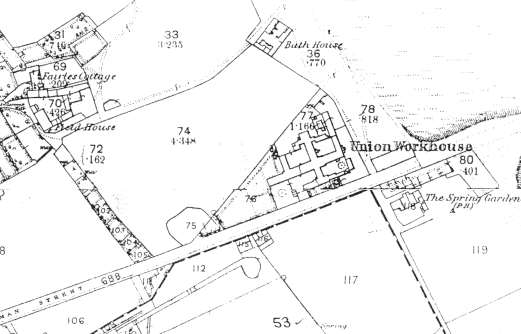
South Shields German Road workhouse site, 1881.
The Harton Moor Workhouse
By the 1870s, the German Street building was proving too small and in 1875 it was decided to build a new workhouse at a site on the edge of Harton Moor. The foundation stone for the new building was laid in September 1877 by the Chairman of the Board of Guardians, Mr WM Anderson JP. The architect for the scheme was Joseph Hall Morton who was also involved in the design of the nearby workhouse at Gateshead. Construction of the building cost £43,361 but the total cost including the purchase of 17 acres from the Church Commissioners was in the region of £55,000.
The new workhouse started admitting paupers in 1878 although the building work was not finally completed until early in 1880. It initially accommodated 700 inmates and comprised an entrance block, main building, infirmary, and schools. The main buildings were based on the then common pavilion layout. The site location and layout are shown on the 1895 map below:
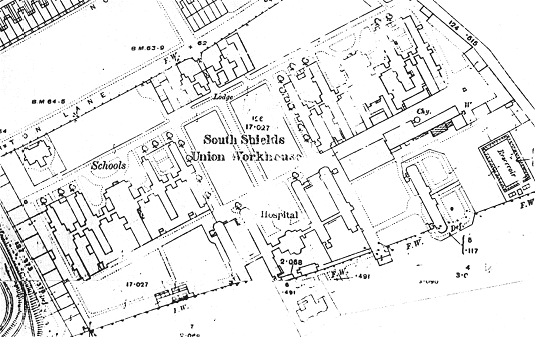
South Shields workhouse site, 1895.
Successive additions were made to the site and by 1910 it was estimated that the cost to date had been £94,750 with the workhouse now able to accommodate 1,200 inmates excluding those in the separate lunatics' block at the south-east of the site.
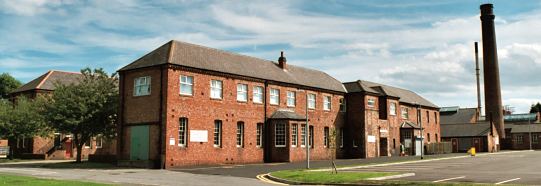
South Shields workhouse eastern pavilions from the north-west, 2001.
© Peter Higginbotham.
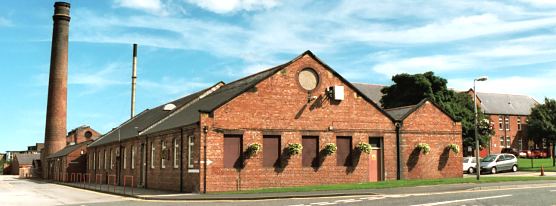
South Shields laundry and workshops with mental block behind from the west, 2001.
© Peter Higginbotham.
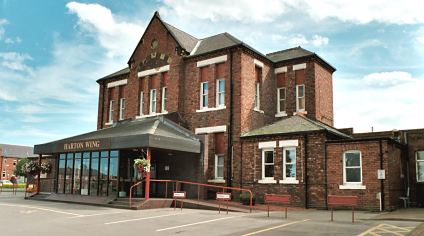
South Shields original hospital administration block from the north-west, 2001.
© Peter Higginbotham.
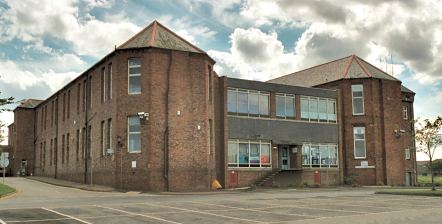
South Shields original hospital western pavilions from the north, 2001.
© Peter Higginbotham.
South Shields workhouse has now become associated with the name of the novelist Catherine Cookson (1906-1998). Born into a poor family at Tyne Dock in South Shields, Catherine left school because of ill health before she was thirteen and followed her mother into domestic service. However, she began to try and educate herself through reading and night classes. At the age of 18, she obtained a job in the South Shields workhouse laundry. After taking a more senior post at Tendring workhouse in Essex, she moved in 1929 to become head laundress at the Hastings workhouse, vowing she would "never, never go back".
After 1930, the workhouse became Harton Institution and General Hospital, then South Shields General Hospital in the late 1940s, and later South Tyneside District Hospital. Only a few of the original workhouse buildings now survive.
Children's Homes
In 1909, South Shields erected a row of cottage homes at Cleadon, about three miles from the main workhouse. The homes provided accommodation for pauper children in "family" groups of fifteen to twenty children, each looked after by a house-mother. There were three pairs of boys' cottages (named Ivy, Sycamore, Snowdrop, Hawthorn, Daisy and Laburnum) and three pairs of girls' cottages (named Pansy, Violet, Rose, Primrose, Maple, and Oak). A staff/adminstrative building was placed between the boys' and girls' homes which were laid out along one side of a "village street". The site layout is shown on the 1913 map below.
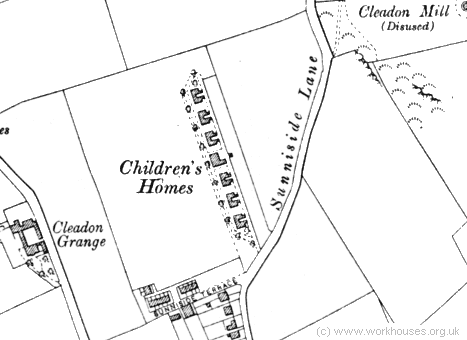
Cleadon Cottage Homes site, 1913.
In 1911, 193 children and 13 officials were in residence at the homes.
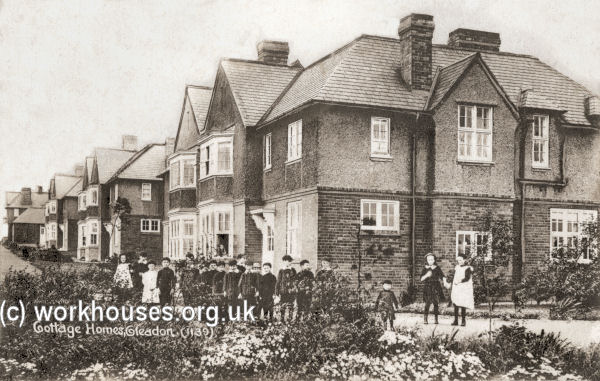
Cleadon Cottage Homes, c.1910.
Another house, known as Woodbine Cottage, was subsequently added at the south of the site for use as a convalescent home, housing up to thirty children.
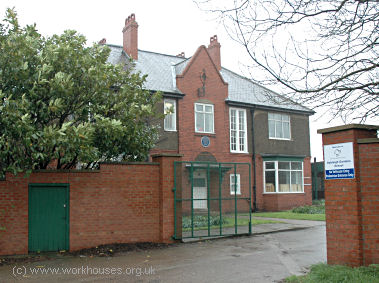
Cleadon Cottage Homes, 2005.
© Peter Higginbotham.
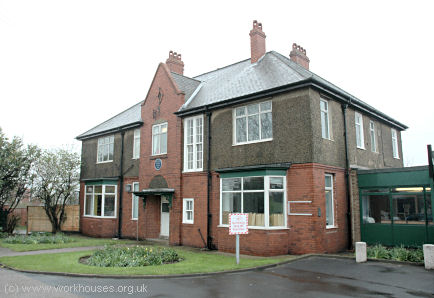
Cleadon Cottage Homes - Woodbine Cottage, 2005.
© Peter Higginbotham.
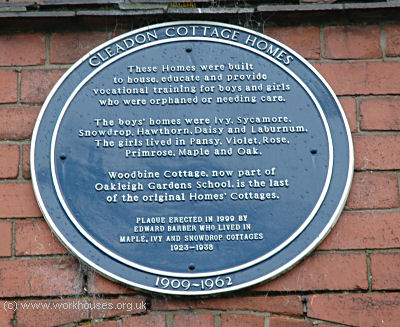
Cleadon Cottage Homes, 2005.
© Peter Higginbotham.
The homes closed in 1962 and the site is now the home of Oakleigh Gardens School. Only the former Woodbine Cottage survives of the original homes.
At the same time as the cottage homes were erected, a receiving home was also built on Harton Lane, to the north of the workhouse, with accommodation for forty children.
Staff
Inmates
Records
Note: many repositories impose a closure period of up to 100 years for records identifying individuals. Before travelling a long distance, always check that the records you want to consult will be available.
- Tyne and Wear Archives, Discovery Museum, Blandford Square, Newcastle upon Tyne NE1 4JA. Guardians' minutes (1899-1932), Births (1914-37), Deaths (1914-48), Admissions (1926-48), Admissions and discharges (1897-1956), Creed registers (1877-1948), Epilepsy registers (1911-36), Lunacy registers (1908-48).
Bibliography
- Higginbotham, Peter The Workhouse Encyclopedia (2014, The History Press)
Links
- None.
Unless otherwise indicated, this page () is copyright Peter Higginbotham. Contents may not be reproduced without permission.


